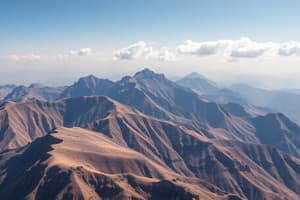Podcast
Questions and Answers
Which branch of geography focuses on human activities and their relationship with the environment?
Which branch of geography focuses on human activities and their relationship with the environment?
- Human Geography (correct)
- Physical Geography
- Geospatial Technology
- Biogeography
Absolute location refers to a place's position relative to other locations.
Absolute location refers to a place's position relative to other locations.
False (B)
Name one sub-discipline of Physical Geography.
Name one sub-discipline of Physical Geography.
geomorphology
Geospatial Technology includes tools like _____, remote sensing, and GPS.
Geospatial Technology includes tools like _____, remote sensing, and GPS.
Match the following types of maps with their descriptions:
Match the following types of maps with their descriptions:
Which climate zone is characterized by being very dry with minimal rainfall?
Which climate zone is characterized by being very dry with minimal rainfall?
Human-Environment Interaction explores how humans modify their environment.
Human-Environment Interaction explores how humans modify their environment.
What are the main categories of major geographical features?
What are the main categories of major geographical features?
The unique characteristics of a location that define its identity are known as _____.
The unique characteristics of a location that define its identity are known as _____.
Which tool is primarily used for visualizing geographic data?
Which tool is primarily used for visualizing geographic data?
Flashcards are hidden until you start studying
Study Notes
Definition of Geography
- Study of the Earth's landscapes, environments, and the relationships between people and their environments.
- Integrates both physical and human aspects.
Branches of Geography
-
Physical Geography
- Focuses on natural features such as landforms, climate, vegetation, and ecosystems.
- Includes sub-disciplines like geomorphology, climatology, and biogeography.
-
Human Geography
- Examines human activities, cultures, economies, and their relationship with the environment.
- Covers areas like urban geography, cultural geography, and economic geography.
-
Geospatial Technology
- Utilizes tools like GIS (Geographic Information Systems), remote sensing, and GPS for spatial analysis.
Key Concepts
-
Location
- Absolute location: Specific coordinates (latitude and longitude).
- Relative location: Position relative to other places.
-
Place
- Characteristics that make a location unique (physical and cultural attributes).
-
Region
- An area defined by certain unifying characteristics (can be physical, cultural, or political).
-
Movement
- Refers to the mobility of people, goods, and ideas across the surface of the Earth.
-
Human-Environment Interaction
- Explores the ways in which humans adapt to and modify their environment.
Major Geographical Features
-
Landforms
- Mountains, valleys, plateaus, plains, hills.
-
Water Bodies
- Oceans, seas, rivers, lakes, and wetlands.
-
Climate Zones
- Tropical, temperate, polar, arid, and continental climates.
Map Types
-
Topographic Maps
- Show elevation and landform features.
-
Political Maps
- Illustrate boundaries, cities, and significant infrastructure.
-
Thematic Maps
- Focus on specific themes or subjects (e.g., population density, climate).
Tools Used in Geography
-
Maps
- Essential for visualizing spatial relationships and geographic data.
-
GIS
- Systems for capturing, analyzing, and displaying geographic data.
-
Remote Sensing
- Technology that collects data from a distance, often using satellites or aircraft.
Importance of Geography
- Understanding spatial relationships and patterns.
- Assessing environmental issues and sustainability.
- Planning urban development and resource management.
- Promoting cultural awareness and global perspectives.
Definition of Geography
- Geography studies the Earth's landscapes, environments, and human-environment interactions.
- It encompasses both physical and human aspects of the world.
Branches of Geography
-
Physical Geography
- Investigates natural features such as landforms, climate, and ecosystems.
- Sub-disciplines include geomorphology (study of landforms), climatology (study of climate), and biogeography (distribution of species).
-
Human Geography
- Focuses on human activities, cultures, economies, and their environmental connections.
- Includes urban geography (study of cities), cultural geography (study of cultures and their spatial significance), and economic geography (study of economic activities).
-
Geospatial Technology
- Employs GIS (Geographic Information Systems), remote sensing, and GPS to analyze spatial data.
Key Concepts
-
Location
- Absolute location uses specific coordinates (latitude and longitude).
- Relative location is described in relation to other places.
-
Place
- Refers to the unique characteristics of a location, encompassing physical and cultural attributes.
-
Region
- A geographic area defined by shared characteristics, which may be physical, cultural, or political.
-
Movement
- Describes the flow of people, goods, and ideas across the Earth's surface.
-
Human-Environment Interaction
- Examines how humans adapt to and alter their environment.
Major Geographical Features
-
Landforms
- Includes mountains, valleys, plateaus, plains, and hills.
-
Water Bodies
- Comprises oceans, seas, rivers, lakes, and wetlands.
-
Climate Zones
- Categorizes regions into tropical, temperate, polar, arid, and continental climates.
Map Types
-
Topographic Maps
- Represent elevation and landform features.
-
Political Maps
- Depict boundaries, cities, and key infrastructure.
-
Thematic Maps
- Concentrate on specific themes or subjects, such as population density or climate zones.
Tools Used in Geography
-
Maps
- Fundamental for visualizing spatial relationships and geographic data.
-
GIS
- Systems that facilitate the capture, analysis, and visualization of geographical information.
-
Remote Sensing
- Technology that acquires data from a distance, often through satellites or aircraft.
Importance of Geography
- Enhances understanding of spatial relationships and patterns.
- Aids in assessing environmental issues and promoting sustainability.
- Important for urban development planning and resource management.
- Fosters cultural awareness and provides global perspectives.
Studying That Suits You
Use AI to generate personalized quizzes and flashcards to suit your learning preferences.




